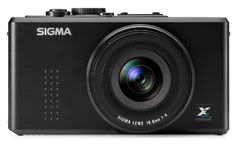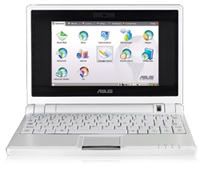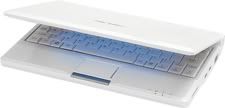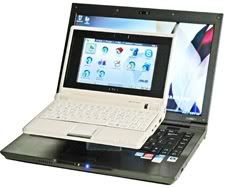Brief Thoughts
This is as much a short review on the notebook as well as a brief review of Microsoft's newest Operating System - Windows Vista.
Part One - The outside
The Acer Extensa 5220 is a mid-range notebook. With laptops, specs are everything - and the Extensa has some respectable figures.
Design-wise it seems decent enough. The body is a mix of a couple of dark greys and black. The outer parts are charcoal grey, and more of the inner sections are darker. The keyboard is black and has no backlighting (bummer). The sides and bottom aren't particularly clean, but that's not to say they're cluttered either. There are a few chrome accents to spice it up but in reality it's nothing particularly inspiring.
Physically, it weighs around 2.8kg, which I found to be quite lightweight. This is probably helped by the fact that it feels extremely balanced - I quite enjoy using it when it's sitting on my lap. It has a standard 1200x800 15.4" LCD. It uses what Acer call their CrystalBrite technology. I personally really enjoy using the screen, and Vista have their screen fonts slightly larger than XP's were for better readability.
The keyboard has an ergonomic perpetual curve which is absolutely love. I got used to the layout in a day and am now typing fairly quickly on it. I find the trackpad to be quite good, especially since it has a scroll wheel on the side.
Part Two - The specs
The all-important specs. If a laptop fails here it simply won't sell.
First off, let me explain that I bought this laptop for simple stuff: emailing, blogging, programming, etc. I wanted a portable workstation, simply an extension to my home computer. As such I didn't need great specs, but Windows Vista demands a minimum level of performance.
It packs an Intel Celeron 1.86 GHz. It's quite good, even though all in all it's nothing special. To compensate for this I got a €60 upgrade to 2GB RAM. It originally had 1GB. I find the computer's multitasking to be more than adequate.
It's got an 80GB hard-drive, which may be considered quite small, indeed I do find it quite limiting, but I plan to add an external USB HDD to compensate.
Part Three - Windows Vista
I was convinced that this was going to be my least favourite part of the computer. I knew Vista to be slow, clunky, and excessively security-oriented - making it extremely annoying to use. However I quickly set about downloading some programs to ease my experience. I highly recommend Tweak UAC.
Very quickly, Vista grew on me. I'm now at the stage where I got used to the interface, and have come to appreciate some of the genuine improvements it offers over XP. I love the new shellstyle(?), and I also like the idea of putting all the networking options in one place. This tripped me up at first but now I prefer it. I managed to connect to the internet just 20 minutes after turning it on for the first time (time includes Vista installation).
Since it's been out for quite a while, there were numerous security updates and other patches to be installed. It was all automated, with Vista installing around 49 updates in total, and I restarted around 4 times, however you could restart at your leisure so it wasn't a problem.
Vista seems to have a bit better memory management than XP. When switching between apps, the machine didn't slowly churn into life; it was a fast and seamless process. I also love the new user log-in page, with the huge user icons.
The eye candy has been kept at a respectable level, the transparency has been disabled (this is Vista Home Basic - no extra eye candy), however I did enable the Aero interface by a little hacking of the registry.
Conclusion
Well, I think that overall I'm extremely satisfied with the Acer Extensa 5220. Now that I've ironed out the workflow bumps and I've taken care of most of the "new computer" bloated pre-installed software, most of which turned out to be really good.
It's a typical mid-range notebook that's not overly capable, and certainly doesn't disappoint. It's a laptop that feels well "sorted". This is supported the very good keyboard and trackpad, as well as the placement of certain elements to enhance usability - including speakers placed in the front, and heat vents in a logical position.
All in all, it's fair to describe it as fairly average, but very useable. I'm certainly very happy with it, and it's not likely to annoy many people.
Rating: Solid Recommendation
Extra: Recommended Programs
Below is a list of programs I recommend to use with Vista. All of them are free downloads. Click on the name to go to their download sites.
- Internet Browser: Mozilla Firefox 2 or Mozilla Firefox 3 beta
- Email: Windows Live Mail (successor to Windows Mail)
- Office: OpenOffice.org (even if you have Microsoft Office 2007)
- File Handling: 7-Zip (handles nearly all compression formats)
- Anti-Virus: Avira AntiVir Personal or PCTools AntiVirus Free


 In June 2007, Asus released the
In June 2007, Asus released the 



